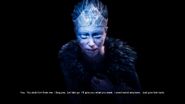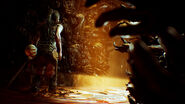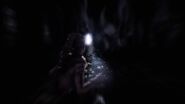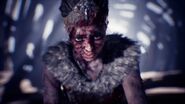(→Personality: corrected the spelling for Helheim) Tag: Visual edit |
(→typo) Tag: Visual edit |
||
| (6 intermediate revisions by 6 users not shown) | |||
| Line 1: | Line 1: | ||
| − | {{Hellblade Character|image1 = |
+ | {{Hellblade Character|image1 = HellbladeIISenua.png|gender = Female|role = Pict warrior, protagonist|portayed_by = Melina Juergens|status = Alive}}'''Senua '''is a Pict warrior and protagonist of [[Hellblade: Senua's Sacrifice|''Hellblade: Senua's Sacrifice'']]'' ''and'' [[Senua's Saga: Hellblade II|Senua's Saga: Hellblade II.]] ''A young woman with a troubled life, exacerbated by severe [[psychosis]], she initially finds herself on a personal journey into the depths of [[Helheim]], in order to save the soul of her lover, [[Dillion]]. |
== Appearance == |
== Appearance == |
||
| − | Senua is a young woman with fair skin, pale blue eyes |
+ | Senua is a young woman with fair skin, pale blue eyes and long dark brown hair. While Senua is slender, she is muscular and has light scars throughout her skin, some more notable on her face. Her hair is tied in a high ponytail and clumped together in plaits and locs coated in lime and adorned with beads. Senua and her people (the ones who lived in her village before abandoning it to the Northmen) were part of a people known as the [https://en.wikipedia.org/wiki/Picts Picts]. |
| + | === ''Hellblade: Senua's Sacrifice'' === |
||
| − | In the |
+ | In the time frame that the original game takes place, Senua wears distinctive woad blue face paint heavily around her eyes, her left arm, across her collar bones and her bottom lip. This type of paint and style has existed among the Pict tribes for centuries; the word "Pict" comes from [https://en.wikipedia.org/wiki/Eumenius Eumenius] in 297 AD, meaning "the painted people". According to many Roman generals and Historians throughout their conquest of the British Isles, tribes like Picts and Iceni would cover themselves in blue paint to blend in the fog before the sun rose. |
| − | Senua wears a leather headpiece decorated with a large silver ornament set with blue stones at the front |
+ | Senua wears a leather headpiece decorated with a large silver ornament set with blue stones at the front and stitched with triskelions (triple spirals) at the sides. She wears a simple plaid and leather outfit, consisting of detailed patterning on the chest, bare arms and a wolf fur collar fastened with a silver brooch. She wears a leather swordbelt, carrying her sword at her left hip, a bag containing Dillion's head and a polished iron mirror that was given to her by [[Druth]]. This mirror is used to gaze into the otherworld. In her opening scene debut, Senua is covered in flecks of mud, dirt and blood. |
| − | Throughout the game, Senua appearance changes; the blue woad |
+ | Throughout the game, Senua's appearance changes; the blue woad on her body and face are almost washed off in her first encounter with Hela. Additionally, regardless of how many times Senua dies, the dark rot on her left arm continues to travel up her neck. As Senua's battle is both mental and physical, she endures injuries, such as a gash on her forehead and facial scars, by the end of the game. |
| + | |||
| + | === ''Senua's Saga: Hellblade II'' === |
||
| + | In the sequel, Senua's face paint has become much more intricate and features a heavy red colour scheme along her entire face and neck, in addition to black markings of runes and other symbols that resemble tattoos. Her chin has been painted a dark colour, giving it the appearance that running liquid is coming out of her mouth. |
||
| + | |||
| + | Senua's headpiece has been simplified, now a curved piece of leather embroiled with the sigil for her [[Focus]]. Her new outfit is based around a more common depiction of armour, though fashioned from multiple leather parts along her chest and shoulders that are held together by loops of metal. She also wears a thin strip of fabric around her right arm. |
||
== Characteristics == |
== Characteristics == |
||
| Line 38: | Line 44: | ||
== ''Hellblade: Senua's Sacrifice'' == |
== ''Hellblade: Senua's Sacrifice'' == |
||
| − | After remembering Druth's instructions to reach the borders of Helheim, Senua finds herself on the outskirts and begins to venture in. As she travels further inside, she begins to remember pieces of her past, including her memories of meeting and spending time with Dillion as well as Druth's stories in order to overcome the obstacles that face her. At every turn, the voices of the [[Psychosis|Furies]] continue to both taunt and encourage her in a confusing contradiction. She is also pursued by an entity called the [[Zynbel|Shadow]], a dark manifested voice that discourages Senua in her efforts to save Dillion, warning that it will always be with her. Despite the Shadow's attempts to stop her, Senua is able to defeat the gods [[Surtr]] and [[Valravn]], as well as the great beast [[ |
+ | After remembering Druth's instructions to reach the borders of Helheim, Senua finds herself on the outskirts and begins to venture in. As she travels further inside, she begins to remember pieces of her past, including her memories of meeting and spending time with Dillion as well as Druth's stories in order to overcome the obstacles that face her. At every turn, the voices of the [[Psychosis|Furies]] continue to both taunt and encourage her in a confusing contradiction. She is also pursued by an entity called the [[Zynbel|Shadow]], a dark manifested voice that discourages Senua in her efforts to save Dillion, warning that it will always be with her. Despite the Shadow's attempts to stop her, Senua is able to defeat the gods [[Surtr]] and [[Valravn]], as well as the great beast [[Garm]], gaining confidence with each new victory over her foes. |
By the time that Senua reaches the inner most sanctum of Helheim and meets Hela, she realises that the Shadow is her mind's manifestation of her father, continuing to abuse her even years after her village was attacked. As Hela herself speaks with the Shadow's voice, she charges through wave after wave of Northmen in an attempt to reach the goddess and kill her. |
By the time that Senua reaches the inner most sanctum of Helheim and meets Hela, she realises that the Shadow is her mind's manifestation of her father, continuing to abuse her even years after her village was attacked. As Hela herself speaks with the Shadow's voice, she charges through wave after wave of Northmen in an attempt to reach the goddess and kill her. |
||
| Line 45: | Line 51: | ||
With the guilt of losing Dillion finally lifted from her mind, Senua is able to accept that the voices in her head are not a curse or a darkness, but simply a part of who she is and that it didn't cause all the plague, Northmen invasion, or her mother's death. As the hellish imagery of Helheim fades away, Senua addresses the player, inviting them to follow her and her Furies as they have another story to tell. |
With the guilt of losing Dillion finally lifted from her mind, Senua is able to accept that the voices in her head are not a curse or a darkness, but simply a part of who she is and that it didn't cause all the plague, Northmen invasion, or her mother's death. As the hellish imagery of Helheim fades away, Senua addresses the player, inviting them to follow her and her Furies as they have another story to tell. |
||
| + | |||
| + | == ''Senua's Saga: Hellblade II'' == |
||
| + | TBA |
||
== Gallery == |
== Gallery == |
||
| Line 59: | Line 68: | ||
== Trivia == |
== Trivia == |
||
* It is unclear how much of Senua's journey is actually real and how much of it is based in the psychotic delusions of her mind. Though there are supernatural elements at play, all of Senua's experiences are based on her interpretations of the Norse stories that Druth told her. The ending scenes seem to symbolise that Senua has come to realise that her psychosis is not a curse, but an illness that she must learn to deal with and the fantasy of confronting the gods fades as she does so. If the player pays close attention, they will notice Hela in the place of Senua. |
* It is unclear how much of Senua's journey is actually real and how much of it is based in the psychotic delusions of her mind. Though there are supernatural elements at play, all of Senua's experiences are based on her interpretations of the Norse stories that Druth told her. The ending scenes seem to symbolise that Senua has come to realise that her psychosis is not a curse, but an illness that she must learn to deal with and the fantasy of confronting the gods fades as she does so. If the player pays close attention, they will notice Hela in the place of Senua. |
||
| − | * Senua could also have a deep fear of becoming like her mother, in regards to the visual presentation of Hela. In Norse mythology, Hela is described as half-rotting, however |
+ | * Senua could also have a deep fear of becoming like her mother, in regards to the visual presentation of Hela. In Norse mythology, Hela is described as half-rotting, however in ''Hellblade,'' Hela is ''half-burned''. When Senua comes to realize the truth of her mother, Galena's face is half-burnt'' ''and her mother's voice speaks through Hela as she drops Dillion's head into the sea below. |
| − | * Druth refers both he |
+ | * Druth refers both to he and Senua as ''geilts''. This is another Irish term and it refers to a person that goes mad from terror or has seen too much battle. Geilts are outsiders among their community, said to have control over illusion, prophets, or seers. The term can also refer to birds (which explains why Druth is wearing feathers). A geilt is definitely not out of the norm for the Celts; other geilts in Celtic legends are Mad Sweeny and Merlin. Merlin, especially, who's Welsh counterpart, Myrddin Wyltt, a madman who lived in the forests and possibly a druid and bard. |
* Senua's namesake comes from a recently discovered ritual spring, a [https://www.theguardian.com/uk/2003/sep/01/arts.highereducation Romano-British goddess] who bares the same name. her name is possibly related to the Proto-Celtic 'seno' meaning "old". Some academics have associated the name to the ancient river Senua that was once located in southern Britain, which may have also been known as Alde, from the Anglo-Saxon 'ald' meaning old. |
* Senua's namesake comes from a recently discovered ritual spring, a [https://www.theguardian.com/uk/2003/sep/01/arts.highereducation Romano-British goddess] who bares the same name. her name is possibly related to the Proto-Celtic 'seno' meaning "old". Some academics have associated the name to the ancient river Senua that was once located in southern Britain, which may have also been known as Alde, from the Anglo-Saxon 'ald' meaning old. |
||
* Senua is performed by Melina Juergens, [[Ninja Theory|Ninja Theory's]] video producer. While the developers were searching for an actress for the role of Senua, they simultaneously had Melina test out the motion capture technology and act out Senua's lines until they decided to use her instead. She had no acting experience prior to this. |
* Senua is performed by Melina Juergens, [[Ninja Theory|Ninja Theory's]] video producer. While the developers were searching for an actress for the role of Senua, they simultaneously had Melina test out the motion capture technology and act out Senua's lines until they decided to use her instead. She had no acting experience prior to this. |
||
Revision as of 23:36, 19 December 2019
Senua is a Pict warrior and protagonist of Hellblade: Senua's Sacrifice and Senua's Saga: Hellblade II. A young woman with a troubled life, exacerbated by severe psychosis, she initially finds herself on a personal journey into the depths of Helheim, in order to save the soul of her lover, Dillion.
Appearance
Senua is a young woman with fair skin, pale blue eyes and long dark brown hair. While Senua is slender, she is muscular and has light scars throughout her skin, some more notable on her face. Her hair is tied in a high ponytail and clumped together in plaits and locs coated in lime and adorned with beads. Senua and her people (the ones who lived in her village before abandoning it to the Northmen) were part of a people known as the Picts.
Hellblade: Senua's Sacrifice
In the time frame that the original game takes place, Senua wears distinctive woad blue face paint heavily around her eyes, her left arm, across her collar bones and her bottom lip. This type of paint and style has existed among the Pict tribes for centuries; the word "Pict" comes from Eumenius in 297 AD, meaning "the painted people". According to many Roman generals and Historians throughout their conquest of the British Isles, tribes like Picts and Iceni would cover themselves in blue paint to blend in the fog before the sun rose.
Senua wears a leather headpiece decorated with a large silver ornament set with blue stones at the front and stitched with triskelions (triple spirals) at the sides. She wears a simple plaid and leather outfit, consisting of detailed patterning on the chest, bare arms and a wolf fur collar fastened with a silver brooch. She wears a leather swordbelt, carrying her sword at her left hip, a bag containing Dillion's head and a polished iron mirror that was given to her by Druth. This mirror is used to gaze into the otherworld. In her opening scene debut, Senua is covered in flecks of mud, dirt and blood.
Throughout the game, Senua's appearance changes; the blue woad on her body and face are almost washed off in her first encounter with Hela. Additionally, regardless of how many times Senua dies, the dark rot on her left arm continues to travel up her neck. As Senua's battle is both mental and physical, she endures injuries, such as a gash on her forehead and facial scars, by the end of the game.
Senua's Saga: Hellblade II
In the sequel, Senua's face paint has become much more intricate and features a heavy red colour scheme along her entire face and neck, in addition to black markings of runes and other symbols that resemble tattoos. Her chin has been painted a dark colour, giving it the appearance that running liquid is coming out of her mouth.
Senua's headpiece has been simplified, now a curved piece of leather embroiled with the sigil for her Focus. Her new outfit is based around a more common depiction of armour, though fashioned from multiple leather parts along her chest and shoulders that are held together by loops of metal. She also wears a thin strip of fabric around her right arm.
Characteristics
Personality
Senua exhibits a very reserved and somewhat meek personality, which stems from her years of isolation and abuse. While on her journey to Helheim, Senua has many experiences that cause her to panic or be afraid, such as when she is trapped in the dark or escaping an inferno. Despite the unpleasantness throughout the journey, she also displays dogged determination, pushing through treacherous landscapes and trials to reach her goal. Whenever she is threatened by an enemy, she readily draws her sword and faces them in combat. Senua is also capable of expressing anger and distress towards obstacles, often in her interactions with the Darkness.
Senua suffers from deep trauma originating from her early childhood, which began to escalate the early stages of her psychosis. Senua's psychosis manifests in both auditory, visual, and sensory hallucinations, leaving her constantly plagued by various female voices dubbed by the game devs as "The Furies". The voices are her guides; they serve as evasive thoughts, doubts, warnings, and even sometimes encouraging. Senua has a tenuous relationship with her voices, occasionally telling them to leave her alone, but she will also listen to their advice in combat and in solving puzzles. For most of the game, she sees the voices as part of a "curse," sometimes trying to fight it. In addition to her psychotic hallucinations, Senua suffers from delusions – a belief maintained even when firmly contradicted by reason or logic. Senua also interacts with her visual hallucinations even when she knows they may not be real, speaking to them when they manifest as people from her past.
Senua also suffers from depression and guilt caused by Dillion's murder, believing that it is her fault for Dillion's death due to her "darkness" inflicting the village. Ridden with this guilt, Senua decides to take his skull (which the Celts believed housed the soul) to Helheim in a desperate attempt to bargain for his soul, fueled by Druth's tales of the Northmen and their mythology. Senua obtains the dark rot from Hela, offering herself in place of Dillion. Through Druth's words, she goes through the gates of Valravn and Surtr, eventually through the trials of Odin to restore the god-killing sword, Gramr. Along her quest, Senua is forced to face the memories of her childhood, the abuse of her father, meeting Dillion, joining his group, and her eventual self-exile.
By the time Senua reaches the final door to Helheim, she has rediscovered a long, repressed memory of her father's fanatic beliefs that drove him to burn her mother alive to cure her of her "darkness". Senua's unyielding and loyal nature pushes her to the brink of death, remaining defiant to Hela despite her admission that she has "nothing else to give" to the goddess. It is then Senua learns to shed not only her guilt for Dillion, but to recgonize that what her father had raised her to think was a lie. And while Senua will always be plagued by her "darkness", she learns to say goodbye to Dillion and remembers what her mother has told her to look at the world with bright eyes. By this, Senua has come to accept that she cannot change her situation nor the fate of a loved one and continues on her quest, with seemingly the only real friends she has left, the voices.
Abilities
Senua is an adept warrior, despite essentially being self-taught. She is capable of quick and heavy attacks, parrying and dodging, and can kick an enemy to prevent it from blocking her attacks. She can also charge an opponent to either get closer or directly attack or kick it.
Her condition gives her a capacity known as "Focus," referencing her tendency to view the world in a different light, which she can use in and out of combat. In combat, if she parries or dodges successfully enough time, she can use her focus ability to move faster than her enemies or dissipate the shadows some of them are made of, which makes them impervious to regular attacks. When using her focus on the lorestones, she triggers a memory of Druth telling her about the Northmen's mythology. Her focus is also used to find runes in environments that will unlock doors or gates that bar her path.
History
Senua's people, the Picts, originated from what is now known as Scotland. More specifically, Senua and her people originate from the Orkney Islands. While it isn't specifically stated in game, through Tameem's comments throughout the Dev Diaries, the player can assume that Senua is the last one of her village, avoiding clashing with the invading Northmen while exiling herself, before Dillion's death.
At a young age, Senua's psychosis manifested itself in visions that only she could see, an ailment she shared with her mother, Galena. Though Galena tried to show Senua that her "sight" was a special thing, her druid father, Zynbel, saw their conditions as "darkness", a curse from the gods that would doom them all. To appease those gods, Zynbel killed Galena by burning her alive when Senua was only five. Senua's trauma at witnessing the event caused her psychosis to worsen and repress the memory, leading her to believe that her mother took her own life to escape her darkness.
For the next few years of her life, Senua was kept inside her home and abused by Zynbel, both emotionally and physically. He would lock her away in a pit and belittle her condition in an effort to defeat the darkness. On one of the rare occasions she was able to leave, she met Dillion, befriending him after observing him practice his swordplay from afar. The two of them eventually fell in love, and Senua saw Dillion as her one ray of light in her darkness, her one hope in a world that seemed to conspire against her. However, after a plague broke out in Senua's village and killed many, including Dillion's father, Senua began to wonder whether Zynbel was right about her condition being a curse.
Senua decided to journey into the Wilds in an effort to protect Dillion and overcome the darkness that plagued her. Out in the Wilds, she encountered Druth, an old scholar who was badly burnt in his attempts to escape his Northmen slave masters. The pair of them bonded as Druth told stories of his captors, giving life to their myths and lore through tales of Norse gods. Though he eventually succumbed to his wounds, he vowed to aid Senua in this life and the next for listening to his stories.
However, once Senua returned home, she found that her village had been attacked by the Northmen that Druth had warned her about. She discovered Dillion, sacrificed in a gruesome display of a "blood eagle" to the Norse gods and suffered a psychotic breakdown. Remembering the stories of the gods she was told, Senua reasoned that if she took Dillion's head to Helheim, the Norse realm of the dead, she would be able to bargain with its ruler, Hela, and win back his soul. There was nothing left for Senua but to journey north.
Hellblade: Senua's Sacrifice
After remembering Druth's instructions to reach the borders of Helheim, Senua finds herself on the outskirts and begins to venture in. As she travels further inside, she begins to remember pieces of her past, including her memories of meeting and spending time with Dillion as well as Druth's stories in order to overcome the obstacles that face her. At every turn, the voices of the Furies continue to both taunt and encourage her in a confusing contradiction. She is also pursued by an entity called the Shadow, a dark manifested voice that discourages Senua in her efforts to save Dillion, warning that it will always be with her. Despite the Shadow's attempts to stop her, Senua is able to defeat the gods Surtr and Valravn, as well as the great beast Garm, gaining confidence with each new victory over her foes.
By the time that Senua reaches the inner most sanctum of Helheim and meets Hela, she realises that the Shadow is her mind's manifestation of her father, continuing to abuse her even years after her village was attacked. As Hela herself speaks with the Shadow's voice, she charges through wave after wave of Northmen in an attempt to reach the goddess and kill her.
When Senua is eventually overwhelmed by her enemies, Hela kneels before her. Senua both curses and pleads with Hela, claiming she's not afraid of sacrificing her life to save Dillion but also begging to set him free. A whirlwind of emotions tears through her mind before finally, Hela kills her. As Senua slumps to the ground, Hela takes Dillion's head to the edge of the battleground and lets it fall into the abyss. As the camera pans back, Hela has become Senua and the corpse on the ground has the appearance of Hela instead.
With the guilt of losing Dillion finally lifted from her mind, Senua is able to accept that the voices in her head are not a curse or a darkness, but simply a part of who she is and that it didn't cause all the plague, Northmen invasion, or her mother's death. As the hellish imagery of Helheim fades away, Senua addresses the player, inviting them to follow her and her Furies as they have another story to tell.
Senua's Saga: Hellblade II
TBA
Gallery
Trivia
- It is unclear how much of Senua's journey is actually real and how much of it is based in the psychotic delusions of her mind. Though there are supernatural elements at play, all of Senua's experiences are based on her interpretations of the Norse stories that Druth told her. The ending scenes seem to symbolise that Senua has come to realise that her psychosis is not a curse, but an illness that she must learn to deal with and the fantasy of confronting the gods fades as she does so. If the player pays close attention, they will notice Hela in the place of Senua.
- Senua could also have a deep fear of becoming like her mother, in regards to the visual presentation of Hela. In Norse mythology, Hela is described as half-rotting, however in Hellblade, Hela is half-burned. When Senua comes to realize the truth of her mother, Galena's face is half-burnt and her mother's voice speaks through Hela as she drops Dillion's head into the sea below.
- Druth refers both to he and Senua as geilts. This is another Irish term and it refers to a person that goes mad from terror or has seen too much battle. Geilts are outsiders among their community, said to have control over illusion, prophets, or seers. The term can also refer to birds (which explains why Druth is wearing feathers). A geilt is definitely not out of the norm for the Celts; other geilts in Celtic legends are Mad Sweeny and Merlin. Merlin, especially, who's Welsh counterpart, Myrddin Wyltt, a madman who lived in the forests and possibly a druid and bard.
- Senua's namesake comes from a recently discovered ritual spring, a Romano-British goddess who bares the same name. her name is possibly related to the Proto-Celtic 'seno' meaning "old". Some academics have associated the name to the ancient river Senua that was once located in southern Britain, which may have also been known as Alde, from the Anglo-Saxon 'ald' meaning old.
- Senua is performed by Melina Juergens, Ninja Theory's video producer. While the developers were searching for an actress for the role of Senua, they simultaneously had Melina test out the motion capture technology and act out Senua's lines until they decided to use her instead. She had no acting experience prior to this.







